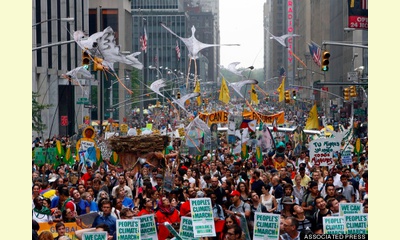|
|
Hundreds Of Thousands Turn Out For People's Climate March In New York City
un article par Nick Visser, The Huffington Post (reproduced within the principles of "fair use")
More than 400,000 people turned out for the People's Climate
March in New York City on Sunday [September 21], just days before
many of the world's leaders are expected to debate environmental
action at the United Nations climate summit. 
Demonstrators make their way down Sixth Avenue in New York during the People's Climate March on Sunday.
click on photo to enlarge
Early reports from event organizers are hailing the turnout as the
largest climate march in history, far bigger than the Forward on
Climate rally held in Washington, D.C., last year. High-profile
environmentalists including Bill McKibben, Leonardo DiCaprio, Jane
Goodall and Vandana Shiva marched alongside policymakers such
as Sens. Sheldon Whitehouse (D-R.I.), Bernie Sanders (I-Vt.) and
Charles Schumer (D-N.Y.). U.N. Secretary-General Ban Ki-moon and
former Vice President Al Gore were also there, and more than 550
buses carried in people from around the country.
The rally comes at an opportune time as 120 world leaders,
including President Barack Obama, are expected to convene
Tuesday at the United Nations in New York to discuss ways to tackle
the growing threat of carbon pollution.
The White House has pledged to "show the world that the U.S. is
leading on climate change, and to call on other leaders to step up to
the plate," John Podesta, who serves as a counselor to the president,
told reporters on Thursday. However, a recent study found that the
world spewed more carbon dioxide into the atmosphere last year
than ever before, primarily driven by China, India and the United
States. And the top leaders of China and India announced earlier
this month that they won't be attending Tuesday's summit.
The march began around 11:30 a.m., at New York City's Columbus
Circle just off Central Park. At times, it stretched more than 4 miles
as marchers carried banners, signs and entire contraptions
depicting everything from Mother Earth herself to the dinosaurs that
now make up fossil fuels.
"Today I march because I want to behold a brighter future. We have
destroyed ourselves. We have destroyed our health and I'm here
because our political leaders have failed us," Stanley Sturgill, a
retired coal miner from Kentucky now suffering from black lung,
said at a press conference before the march. "We know together we
can build our bright future."
More than 1,500 groups filled Central Park West before the march.
They represented a variety of interests, including the scientific
community and religious organizations. More than 50,000 students
were there because they were worried about their future, while
grandparents came out of concern for their legacy.
"We need to act now ... We only have one atmosphere and we of the
Marshall Islands only have one land to call 'home,'" Kathy Jetnil-
Kijiner, a young mother from the island nation, said before the
march. "We don't want to move and we shouldn't have to move."
|








|
DISCUSSION
Question(s) liée(s) à cet article:
Despite the vested interests of companies and governments, Can we make progress toward sustainable development?
* * * * *
Commentaire le plus récent:
[responding to CPNN article The film 'Demain', a manifesto?
Yes initiatives from the grassroots are important and necessary which will have a direct impact on the present and the future. But there are governments like India which are conscious of over exploitation of the earth’s resources and are taking suitable policy measures and also taking legal action against the exploiters.
We must emphasize public transportation and reduce our dependence on individual cars even though the auto industry will not like this.
Otherwise it is not demain but aujourdhui — the problems are there for us to see.

|
|









